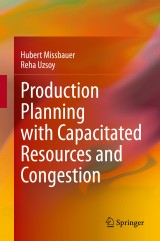Details

Production Planning with Capacitated Resources and Congestion
|
CHF 118.00 |
|
| Verlag: | Springer |
| Format: | |
| Veröffentl.: | 26.02.2020 |
| ISBN/EAN: | 9781071603543 |
| Sprache: | englisch |
Dieses eBook enthält ein Wasserzeichen.
Beschreibungen
This book presents a comprehensive overview of recent developments in production planning. The monograph begins with an introductory chapter reviewing the need for these production planning models, that operate by determining time-phased releases of work into the facility or supply chain, relating these to the Manufacturing Planning and Control (MPC) and Advanced Planning and Scheduling (APS) frameworks, that form the basis of most academic research and industrial practice. The extensive body of work on Workload Control is also placed in this context, and proves the need for improved models with a discussion of the difficulties, these approaches encounter.<br>The next two chapters present a detailed review of the state of the art in optimization models based on exogenous planned lead times, and examines the cases where these can take both integer and fractional values. The difficulties arising in estimating planned lead times are consistent with factory behavior which are highlighted, noting that many of these lead to non-convex optimization models. Attempts to address these difficulties by iterative multimodel approaches, that combine simulation and mathematical programming, are also discussed in detail. The next three chapters of the volume address the set of techniques developed using clearing functions, which represent the expected output of a resource in a planning period, as a function of the expected workload of the resource, during that period.<br>The chapters on this subject propose a basic optimization model for multiple products, discuss the difficulties of this model and some possible solutions. It also reviews prior work, and discuss a number of alternative formulations of the clearing function concept with their respective advantages and disadvantages. Applications to lot sizing decisions and a number of other specific problems are also described. This volume concludes with an assessment of the state of the art described in the volume, and several directions for future work.
Chapter 1. Introduction.- Chapter 2. Workload and Cycle Time in the Production Unit.- Chapter 3. Production Planning and Control Frameworks.- Chapter 4. The Workload Control Approach.- Chapter 5. Planning Models with Stationary Fixed Lead Times.- Chapter 6. Time - Varying Lead Times and Iterative Multi - Model Approaches.- Chapter 7. Univariate Clearing Functions.- Chapter 8. Multivariate Clearing Functions.- Chapter 9. Lot Sizing Models Using Multidimensional Clearing Functions.- Chapter 10. Applications of Clearing Functions.- Chapter 11. Conclusions and Future Directions.
<b>Hubert Missbauer</b> is Professor of Production and Logistics Management in the Department of Information Systems, Production and Logistics Management at the University of Innsbruck, Austria. His teaching and research interests are in production and logistics management, production planning and control, and quantitative models in management. <div><b>Reha Uzsoy</b> is Clifton A. Anderson Distinguished Professor in the Edward P. Fitts Department of Industrial and Systems Engineering at North Carolina State University. His teaching and research interests are in production planning and supply chain management.<br></div>
This book presents a comprehensive overview of recent developments in production planning. The monograph begins with an introductory chapter reviewing the need for these models of production planning that operate by determining time-phased releases of work into the facility or supply chain, relating these to the Manufacturing Planning and Control (MPC) and Advanced Planning and Scheduling (APS) frameworks that form the basis of most academic research and industrial practice. The extensive body of work on Workload Control is also placed in this context, and the need for improved models motivated by a discussion of the difficulties these approaches encounter.<br>The next two chapters present a detailed review of the state of the art in optimization models based on exogenous planned lead times, examining the cases where these can take both integer and fractional values. The difficulties arising in estimating planned lead times that are consistent with factory behavior are highlighted, noting that many of these lead to non-convex optimization models. Attempts to address these difficulties by iterative multimodel approaches that combine simulation and mathematical programming are also discussed in detail. The next three chapters of the volume address the set of techniques developed using clearing functions, which represent the expected output of a resource in a planning period as a function of the expected workload of the resource during that period.<br>The chapters on this subject propose a basic optimization model for multiple products, discuss the difficulties of this model and some possible solutions, review prior work, and discuss a number of alternative formulations of the clearing function concept with their respective advantages and disadvantages. Applications to lot sizing decisions and a number of other specific problems are also described. The volume concludes with an assessment of the state of the art described in the volume, and several directions forfuture work.
Concise monograph brings field completely up to date Presents clearing function models and their applications Authors are among the most prominent names in the field
Diese Produkte könnten Sie auch interessieren:

Supply Chain Management: Models, Applications, and Research Directions

von: Joseph Geunes, Panos M. Pardalos, H. Edwin Romeijn

CHF 177.00















